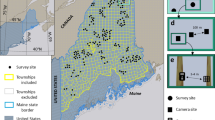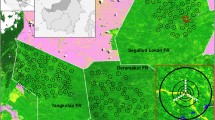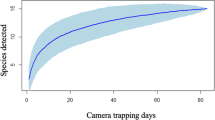Abstract
Field-based primate studies often make population inferences using count-based indices (e.g., individuals/plot) or distance sampling; the first does not account for the probability of detection and thus can be biased, while the second requires large sample sizes to obtain precise estimates, which is difficult for many primate studies. We discuss photographic sampling and occupancy modeling to correct for imperfect detection when estimating system states and dynamics at the landscape level, specifically in relation to primate ecology. We highlight the flexibility of the occupancy framework and its many applications to studying low-density primate populations or species that are difficult to detect. We discuss relevant sampling and estimation procedures with special attention to data collection via photographic sampling. To provide tangible meaning to terminology and clarify subtleties, we use illustrative examples. Photographic sampling can have many advantages over observer-based sampling, especially when studying rare or elusive species. Combining photographic sampling with an occupancy framework allows inference to larger scales than is common in primate studies, addresses uncertainty due to the observation process, and allows researchers to examine questions of how landscape-level anthropogenic changes affect primate distributions.



Similar content being viewed by others
References
Abad-Franch, F., Ferraz, G., Campos, C., Palomeque, F., Grijalva, M., Aguilar, H., Miles, M. (2010). Modeling disease vector occurrence when detection is imperfect: Infestation of Amazonian palm trees by triatomine bugs at three spatial scales. PLoS Neglected Tropical Diseases, 4, e620.
Ahumada, J.A., Silva, C.E.F., Gajapersad, K., Hallam, C., Hurtado, J., Martin, E. (2011). Community structure and diversity of tropical forest mammals: Data from a global camera trap network. Philosophical Transactions of the Royal Society B: Biological Sciences, 4, 2703–2711.
Anderson, D.R. (2001). The need to get the basics right in wildlife field studies. Wildlife Society Bulletin, 29, 1294–1297.
Andrewartha, H., & Birch, L. (1954). In The distribution and abundance of animals. Chicago: University of Chicago Press.
Bailey, L., Hines, J., Nichols, J., MacKenzie, D. (2007). Sampling design trade-offs in occupancy studies with imperfect detection: Examples and software. Ecological Applications, 17, 281–290.
Bailey, L., Reid, J., Forsman, E., Nichols, J. (2009). Modeling co-occurrence of northern spotted and barred owls: Accounting for detection probability differences. Biological Conservation, 142, 2983–2989.
Baker, L., Arnold, T., Olubode, O., Garshelis, D. (2011). Considerations for using occupancy surveys to monitor forest primates: A case study with sclaters monkey (Cercopithecus sclateri). Population Ecology, 53, 549–561.
Brus, D., & De Gruijter, J. (1997). Random sampling or geostatistical modelling? Choosing between design-based and model-based sampling strategies for soil (with discussion). Geoderma, 80, 1–44.
Buckland, S.T., Anderson, D.R., Burnham, K.P., Laake, J.L., Borchers, D.L., Thomas, L. (2001). In Introduction to distance sampling. Oxford: Oxford University Press.
Buckland, S.T., Plumptre, A.J., Thomas, L., Rexstad, E.A. (2010a). Line transect sampling of primates: Can animal-to-observer distance methods work? International Journal of Primatology, 31, 485–499.
Buckland, S.T., Plumptre, A.J., Thomas, L., Rexstad, E.A. (2010b). Design and analysis of line transect surveys for primates. International Journal of Primatology, 31, 833–847.
Burnham, K.P., & Anderson, D.R. (2002). Model selection and multi-model inference: A practical information-theoretic approach. New York: Springer.
Burton, A.C., Sam, M.K., Balangtaa, C., Brashares, J.S. (2012). Hierarchical multi-species modeling of carnivore responses to hunting, habitat and prey in aWest African protected area. PloS one, 7, e38007.
Chapman, C.A., & Peres, C.A. (2001). Primate conservation in the new millennium: The role of scientists. Evolutionary Anthropology, 10, 16–33.
Cochran, W.G. (1977). In Sampling techniques. New York: Wiley.
Cowlishaw, G., & Dunbar, R. (2000). Primate conservation biology. Chicago: University of Chicago Press.
Doherty, P.F.,White, G.C., Burnham, K.P. (2012). Comparison of model building and selection strategies. Journal of Ornithology, 152, 1–7.
Efford, M., & Dawson, D. (2012). Occupancy in continuous habitat. Ecosphere, 3, art32.
Fashing, P.J., & Cords, M. (2000). Diurnal primate densities and biomass in the Kakamega Forest: An evaluation of census methods and a comparison with other forests. American Journal of Primatology, 50, 139–152.
Fiske, I., & Chandler, R. (2011). Unmarked: An r package for fitting hierarchical models of wildlife occurrence and abundance. Journal of Statistical Software, 43, 123.
Gerber, B., Karpanty, S., Crawford, C., Kotschwar, M., Randrianantenaina, J. (2010). An assessment of carnivore relative abundance and density in the eastern rainforests of Madagascar using remotely-triggered camera traps. Oryx, 44, 219–222.
Gerber, B., Karpanty, S., Randrianantenaina, J. (2012). The impact of forest logging and fragmentation on carnivore species composition, density and occupancy in madagascars rainforests. Oryx, 46, 414–422.
Gormley, A., Forsyth, D., Griffioen, P., Lindeman, M., Ramsey, D., Scroggie, M., Woodford, L. (2011). Using presence-only and presence-absence data to estimate the current and potential distributions of established invasive species. Journal of Applied Ecology, 48, 2534.
Gregoire, T. (1998). Design-based and model-based inference in survey sampling: Appreciating the difference. Canadian Journal of Forest Research, 28, 1429–1447.
Guillera-Arroita, G., Lahoz-Monfort, J.,Milner-Gulland, E., Young, R., Nicholson, E. (2010). Using occupancy as a state variable for monitoring the critically endangered Alaotran gentle lemur Hapalemur alaotrensis. Endangered Species Research, 11, 157–166.
Guschanski, K., Vigilant, L., McNeilage, A., Gray, M., Kagoda, E., Robbins, M.M. (2009). Counting elusive animals: Comparing eld and genetic census of the entiremountain gorilla population of Bwindi Impenetrable National Park, Uganda. Biological Conservation, 142, 290–300.
Harcourt, A., & Doherty, D. (2005). Species-area relationships of primates in tropical forest fragments: A global analysis. Journal of Applied Ecology, 42, 630–637.
Hilborn, R., & Mangel, M. (1997). The ecological detective: Confronting models with data. Princeton, NJ: Princeton University Press.
Hines, J.E. (2013). Presence 5.5. Software to estimate patch occupancy and related parameters. USGS-PWRC. http://www.mbr-pwrc.usgs.gov/software/presence.shtml.
IUCN (2012). The iucn red list of threatened species. Version 20122. http://www.iucnredlist.org. Downloaded on 17 October 2012.
Karanth, K., Nichols, J., Hines, J. (2010). Occurrence and distribution of indian primates. Biological Conservation, 143, 2891–2899.
Kays, R., & Slauson, K. (2008). Remote cameras. In R.A. Long, P. MacKay, W.J. Zielinski, J. Ray (Eds.), Noninvasive survey methods for carnivores (pp. 110–140). Washington, DC: Island Press.
Keane, A., Hobinjatovo, T., Razafimanahaka, H., Jenkins, R., Jones, J. (2012). The potential of occupancy modelling as a tool for monitoring wild primate populations. Animal Conservation, 15, 457–465.
Kendall, W., & White, G. (2009). A cautionary note on substituting spatial subunits for repeated temporal sampling in studies of site occupancy. Journal of Applied Ecology, 46, 1182–1188.
Kucera, T., & Barrett, R. (2010). A history of camera trapping. In: A.F.O’Connell, J. D. Nichols, K. U. Karanth (Eds), Camera traps in animal ecology: Methods and analyses (pp. 9–26). New York: Springer.
Little, R.J. (2004). To model or not to model? Competing modes of inference for finite population sampling. Journal of the American Statistical Association, 99, 546–556.
Lukacs, P.M., Burnham, K.P., Anderson, D.R. (2010).Model selection bias and freedmans paradox. Annals of the Institute of Statistical Mathematics, 62, 117–125.
Lunn, D., Spiegelhalter, D., Thomas, A., Best, N. (2009). The bugs project: Evolution, critique and future directions. Statistics in Medicine, 28, 3049–3067.
MacKenzie, D., & Nichols, J. (2004). Occupancy as a surrogate for abundance estimation. Animal Biodiversity and Conservation, 27, 461–467.
MacKenzie, D., Nichols, J., Hines, J., Knutson, M., Franklin, A. (2003). Estimating site occupancy, colonization, and local extinction when a species is detected imperfectly. Ecology, 84, 2200–2207.
MacKenzie, D., Nichols, J., Lachman, G., Droege, S., Royle, J.A., Langtimm, C. (2002). Estimating site occupancy rates when detection probabilities are less than one. Ecology, 83, 2248–2255.
MacKenzie, D., & Royle, J. (2005). Designing occupancy studies: General advice and allocating survey effort. Journal of Applied Ecology, 42, 1105–1114.
MacKenzie, D., Nichols, J., Royle, 674 J., Pollock, K., Bailey, L., Hines, J. (2006). Occupancy estimation and modeling: Inferring patterns and dynamics of species occurrence. New York: Academic Press.
Martins, S.S., Sanderson, J.G., e Silva-Júnior, J.S. (2007). Monitoring mammals in the Caxiuanã National Forest, Brazil-first results from the tropical ecology, assessment and monitoring (TEAM) program. Vertebrate Conservation and Biodiversity, 16, 31–44.
Miller, D., Nichols, J., McClintock, B., Grant, E., Bailey, L., Weir, L. (2011). Improving occupancy estimation when two types of observational error occur: Non-detection and species misidentification. Ecology, 92, 1422–1428.
Nichols, J. (1992). Capture-recapture models. BioScience, 42, 94–102.
Nichols, J., Bailey, L., Talancy, N., Campbell, G., Gilbert, A., Annand, E. et al. (2008). Multi-scale occupancy estimation and modelling using multiple detection methods. Journal of Applied Ecology, 45, 1321–1329.
O’Connell, A., Nichols, J., Karanth, K. (2010). Camera traps in animal ecology: Methods and analyses. In: New York: Springer.
O’Connell, A., Talancy, N., Bailey, L., Sauer, J., Cook, R., Gilbert, A. (2006). Estimating site occupancy and detection probability parameters for meso-and large mammals in a coastal ecosystem. Journal of Wildlife Management, 70, 1625–1633.
Olson, E., Marsh, R., Bovard, B., Randrianarimanana, H., Ravaloharimanitra, M., Ratsimbazafy, J., King, T. (2012). Arboreal camera trapping for the critically endangered greater bamboo lemur Prolemur simus. Oryx, 46, 593–597.
Plumptre, A.J. (2000). Monitoring mammal populations with line transect techniques in african forests. Journal of Applied Ecology, 37, 356–368.
R Core Team (2013). R: A language and environment for statistical computing. Vienna, Austria: R Foundation for Statistical Computing.
Ross, C., & Reeve, N. (2003). Survey and census methods: Population distribution and density. Field and laboratory methods in primatology. In J.M. Setchell & D.J. Curtis (Eds.), Field and laboratory methods in primatology: A practical guide, (pp. 90–109). Cambridge, U.K.: Cambridge University Press.
Royle, J., & Dorazio, R. (2008). Hierarchical modeling and inference in ecology: The analysis of data from populations, metapopulations and communities. New York: Academic Press.
Royle, J., & Link, W. (2006). Generalized site occupancy models allowing for false positive and false negative errors. Ecology, 87, 835–841.
Royle, J.A., & Nichols, J.D. (2003). Estimating abundance from repeated presence-absence data or point counts. Ecology, 84, 777–790.
Royle, J.A., Nichols, J.D., Kèry, M. (2005). Modelling occurrence and abundance of species when detection is imperfect. Oikos, 110, 353–359.
S̈arndal, C.E., Thomsen, I., Hoem, J.M., Lindley, D.V., Barndorff-Nielsen, O., Dalenius, T. (1978). Design-based and model-based inference in survey sampling [with discussion and reply]. Scandinavian Journal of Statistics, 5, 27–52.
Thompson, S. (2012). Sampling. Hoboken, NJ: Wiley.
Thompson,W. (2004). Sampling rare or elusive species: Concepts, designs, and techniques for estimating population parameters. Washington, D.C.: Island Press.
Vojta, C.D. (2005). Old dog, new tricks: Innovations with presence-absence information. Journal of Wildlife Management, 69, 845–848.
White, G., & Burnham, K. (1999). Program mark: Survival estimation from populations of marked animals. Bird Study, 46, 120–139.
Wiewel, A.S., Adams, A.A.Y., Rodda, G.H. (2009). Evaluating abundance estimate precision and the assumptions of a count-based index for small mammals. The Journal of Wildlife Management, 73, 761–771.
Zhan, X., Li, M., Zhang, Z., Goossens, B., Chen, Y., Wang, H., Bruford, M., Wei, F. (2006). Molecular censusing doubles giant panda population estimate in a key nature reserve. Current Biology, 16, R451–R452.
Acknowledgments
We thank Marni LaFleur and Chia Tan for inviting us to contribute to this special issue. We are also grateful to Marni LaFleur, Joanna Setchell, and two anonymous reviewers for useful comments that helped improve this manuscript.
Author information
Authors and Affiliations
Corresponding author
Electronic supplementary material
Below is the link to the electronic supplementary material.
Rights and permissions
About this article
Cite this article
Gerber, B.D., Williams, P.J. & Bailey, L.L. Primates and Cameras. Int J Primatol 35, 841–858 (2014). https://doi.org/10.1007/s10764-014-9761-9
Received:
Accepted:
Published:
Issue Date:
DOI: https://doi.org/10.1007/s10764-014-9761-9




